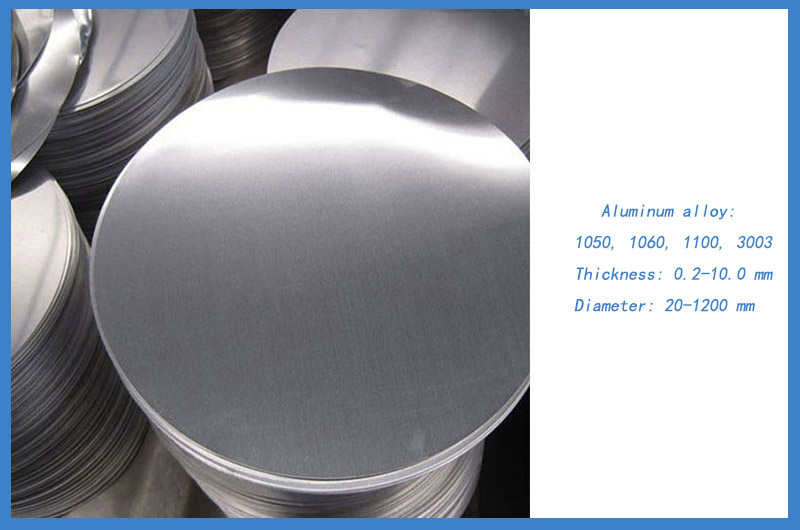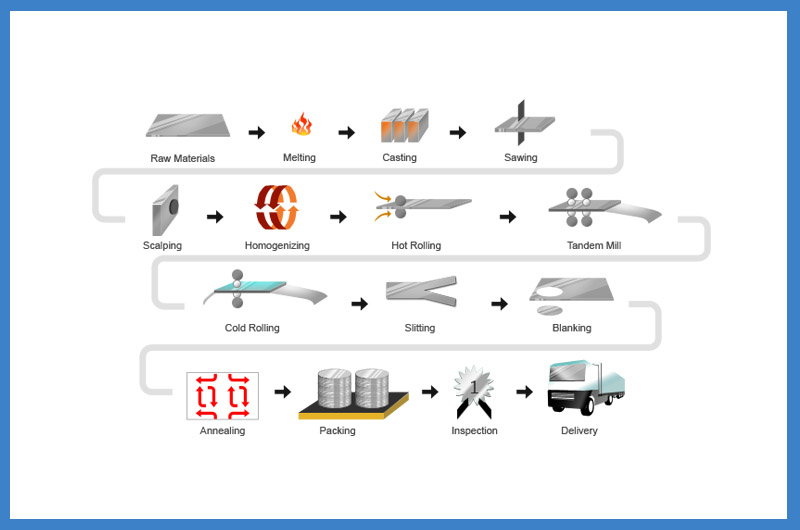CC Aluminum Circle
CC Aluminum Circle refers to aluminum circles produced through the Continuous Casting (CC) process.
Unlike DC aluminum circles, CC circles offer advantages such as ease of processing and lower cost.

CC Aluminum Circle Material Specifications
- Aluminum Alloys: CC aluminum circles are typically made from common aluminum alloys such as 1050, 1060, 1100, 3003, etc., which offer good ductility and formability.
- States: O, H12, H14, H16, H18, H22, H24, H26, H32, etc.
- Thickness: 0.2-10.0 mm
- Diameter: 20-1200 mm
- Minimum Order Quantity: 500 kg
- Applications: Road signs, cookware, lamp shades, kitchen utensils, soup pots, frying pans, rice cookers, lighting fixtures, traffic/road signs, etc.
- Specific specifications can be customized according to customer requirements.
Advantages of CC Aluminum Circle Disc
- 1. Efficient Production: The continuous casting process allows for high-efficiency production of aluminum circles, reducing intermediate steps in traditional casting and rolling processes, thus increasing production efficiency.
- 2. Low Cost: With reduced production steps and equipment investment, the CC process has relatively low production costs, providing significant economic advantages for mass production.
- 3. Good Uniformity: The continuous casting process produces aluminum circles with uniform thickness and stable performance, meeting high standards of application requirements.
Performance of CC Aluminum Circle
- 1. Good Formability: With the use of aluminum alloy materials, CC aluminum circles exhibit good ductility and formability, suitable for deep drawing and stamping processes.
- 2. Excellent Corrosion Resistance: Aluminum itself has strong oxidation resistance and can form a dense oxide film on the surface, providing excellent corrosion resistance, especially suitable for humid or acidic environments.
- 3. Lightweight: The light weight of aluminum reduces the overall weight of structures, which is significant for energy savings and reducing transportation costs.
Applications of CC Aluminum Circle
- Cookware: Due to its good thermal conductivity and formability, CC aluminum circles are commonly used to produce pots, frying pans, and other cookware.
- Appliance Housings: CC aluminum circles are also widely used in the production of appliance housings, such as washing machines and microwaves.
- Signage and Nameplates: Due to its good appearance and ease of processing, CC aluminum circles can also be used to produce various types of signage and nameplates.
- Automotive and Aerospace Industries: In the automotive and aerospace industries, CC aluminum circles are used to manufacture lightweight structural components, helping to reduce the weight of vehicles and aircraft.
Surface Treatment of CC Aluminum Circle
Common Surface Treatments: CC aluminum circles can be surface treated as needed, such as anodizing, coating, etc., to enhance their corrosion resistance and decorative properties.
CC aluminum circles are versatile and high-performance aluminum products, widely used in applications requiring lightweight, corrosion resistance, and good formability.
Haomei Aluminum CC aluminum circles feature high strength, formability, and excellent corrosion resistance and can be further processed through deep drawing, spinning, and other methods.
CC Aluminum Circle Production Process
The continuous casting (CC) process is an efficient and economical method for producing aluminum circles, particularly suitable for large-scale production.
1. Aluminum Liquid Casting
Aluminum Liquid Preparation: The aluminum liquid typically consists of aluminum blocks or alloys melted in an aluminum smelting furnace, refined and filtered to remove impurities, ensuring the purity and quality of the liquid aluminum.
Casting System: The aluminum liquid flows into a mold through the nozzle of the casting machine. The mold usually consists of two cooled metal plates that hold the aluminum liquid during casting. The aluminum liquid solidifies in the mold to form a preliminary aluminum strip.
2. Cold Rolling or Hot Rolling Processing
Cold Rolling: The preliminary cast aluminum strip is processed through a cold rolling mill, where multiple rollers compress the strip, reducing its thickness and improving its surface finish. Cold rolling occurs at room temperature and can further refine the thickness and properties of the aluminum strip.
Hot Rolling (if required): If specific thermal treatment properties are needed for the aluminum circles, the preliminary cast aluminum strip may undergo hot rolling. Hot rolling occurs at high temperatures, which helps improve the plasticity and flowability of the aluminum material, achieving the desired thickness.
3. Quality Control and Post-Processing
Quality Inspection: During the continuous casting process, aluminum circles undergo a series of quality checks, including thickness measurement, surface defect detection, and strength testing, to ensure the products meet specification requirements.
Cutting and Coiling: After rolling, the aluminum strip is cut into the required circle sizes or coiled for subsequent processing and use.
Deep drawing performance of cast aluminum circles is generally poorer compared to hot-rolled aluminum circles and is rarely used for deep drawing. High-quality aluminum circles are typically hot-rolled products, with no color difference after anodizing and strong ductility, suitable for stretching, deep drawing, spinning, anodizing, and other subsequent processes.

Chemical composition of CC aluminum circle disc
| Alloy | Si | Fe | Cu | Mn | Mg | Zn | V | Ti | Other | Al |
| 1050 | 0.25 | 0.4 | 0.05 | 0.05 | 0.05 | 0.05 | 0.05 | 0.03 | 0.03 | 99.5 |
| 1060 | 0.25 | 0.35 | 0.05 | 0.03 | 0.03 | 0.05 | 0.05 | 0.03 | 0.03 | 99.6 |
| 1100 | 0.95 | 0.95 | 0.05-0.2 | 0.05 | / | 0.1 | / | / | 0.05 | 99 |
| 3003 | 0.6 | 0.7 | 0.05-0.2 | 1.0-1.5 | / | 0.1 | / | / | 0.15 | 96.95-96.75 |
